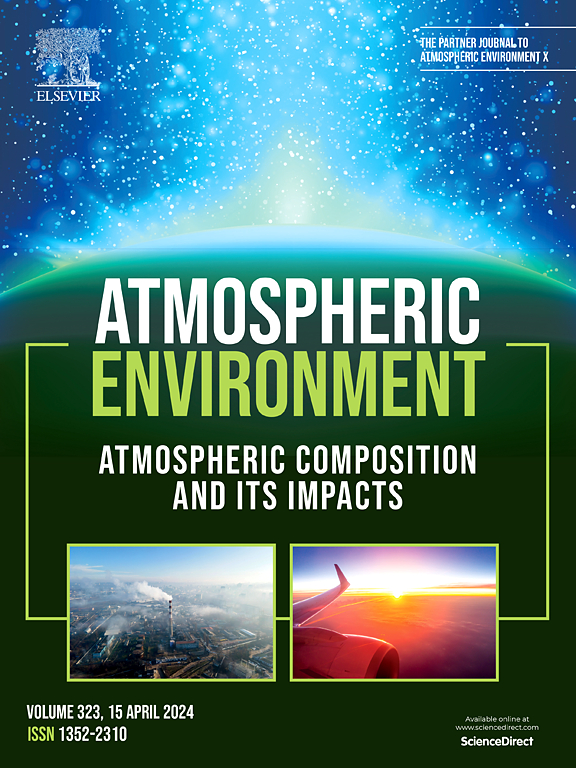基于光化学损失的连云港VOCs源解析:对反应性、O3和SOA形成的影响
IF 4.2
2区 环境科学与生态学
Q2 ENVIRONMENTAL SCIENCES
引用次数: 0
摘要
挥发性有机物(VOCs)源解析为臭氧(O3)和颗粒物污染防治提供了科学依据,但基于实测浓度的受体模型存在偏差。通过对连云港市(中国东部工业快速发展的城市)2023年1月和7月多种VOCs的小时浓度在线测量,结合二次气溶胶(SOAP)和O3 (OFP)的光化学损失和形成势,改进了正矩阵分解(PMF)模型的应用,确定了VOCs的5个主要来源。1月和7月总挥发性有机化合物(TVOC)浓度分别为23.7±10.8和12.0±7.5 ppbv,白天因光化学损失而消耗的平均挥发性有机化合物(VOCs)分别为3.12和3.08 ppb。其浓度普遍低于中国特大城市。氧化VOCs (Oxygenated VOCs, OVOCs)是连云港市重要的工业排放源,在TVOCs浓度结构和光化学损失中占有重要地位。纳入光化学损失避免了对溶剂使用贡献的低估和对夏季车辆排放的高估。基于浓度和环境影响的源贡献之间存在显著差异(冬季为SOAP,夏季为OFP)。对于后者,燃煤在1月份被确定为最重要的污染源,工业排放和溶剂使用在7月份被确定为最重要的污染源。从反向轨迹来看,当地排放是VOCs污染的主要来源,主要来自大型港口和工业园区,而邻近省份(山东和安徽)的工业排放也很重要。分析结果为快速工业化城市VOCs排放控制重点的确定提供了科学依据。本文章由计算机程序翻译,如有差异,请以英文原文为准。
Source apportionment of VOCs based on photochemical loss in Lianyungang: implications to reactivity, O3 and SOA formation
Source apportionment of volatile organic compounds (VOCs) provides scientific basis for the prevention of ozone (O3) and particulate matter pollution, while bias exists in the receptor model based on the measured concentration. We conducted online measurement of hourly ambient concentrations for multiple VOCs species in January and July 2023 in Lianyungang, a city with fast growing industry in east China, and five major sources of VOCs were identified with an improved application of the positive matrix factorization (PMF) model by considering photochemical losses and formation potential of secondary aerosols (SOAP) and O3 (OFP). For January and July, the total VOCs (TVOC) concentrations were measured at 23.7 ± 10.8 and 12.0 ± 7.5 ppbv, and the averaged consumed VOCs due to photochemical losses in daytime reached 3.12 and 3.08 ppb, respectively. The concentrations were generally lower than those in Chinese mega cities. As the important emission from industrial sources, Oxygenated VOCs (OVOCs) were found to occupy a significant position in the concentration structure of TVOCs and photochemical losses in Lianyungang. Inclusion of photochemical losses avoided underestimation of contribution from solvent usage and overestimation of vehicle emissions in summer. There was a significant difference between source contributions based on concentrations and environmental impacts (SOAP in winter and OFP in summer). For the latter, coal burning was identified as the most important source in January, and industrial emissions and solvent usage in July. Indicated by the backward trajectories, local emissions were the dominant contributor to the VOCs pollution, mainly from the large ports and industrial parks, while industrial emissions from nearby provinces (Shandong and Anhui) were also important. The analyses provide scientific evidences for determining the priorities of VOCs emission controls for cities with fast industrialization.
求助全文
通过发布文献求助,成功后即可免费获取论文全文。
去求助
来源期刊

Atmospheric Environment
环境科学-环境科学
CiteScore
9.40
自引率
8.00%
发文量
458
审稿时长
53 days
期刊介绍:
Atmospheric Environment has an open access mirror journal Atmospheric Environment: X, sharing the same aims and scope, editorial team, submission system and rigorous peer review.
Atmospheric Environment is the international journal for scientists in different disciplines related to atmospheric composition and its impacts. The journal publishes scientific articles with atmospheric relevance of emissions and depositions of gaseous and particulate compounds, chemical processes and physical effects in the atmosphere, as well as impacts of the changing atmospheric composition on human health, air quality, climate change, and ecosystems.
 求助内容:
求助内容: 应助结果提醒方式:
应助结果提醒方式:


